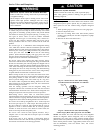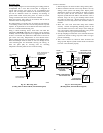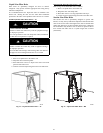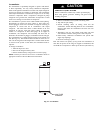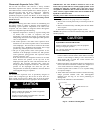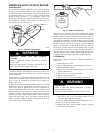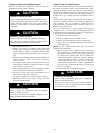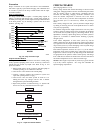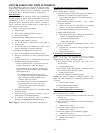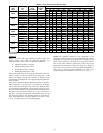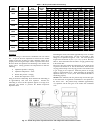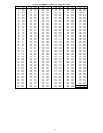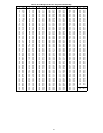
32
Compressor Removal and Replacement
Once it is determined that compressor has failed and the reason
established, compressor must be replaced.
PERSONAL INJURY HAZARD
Failure to follow this caution may result in personal injury.
Turn off all power to unit before proceeding. Wear safety
glasses, protective clothing, and gloves when handling
refrigerant. Acids formed as a result of motor burnout can
cause burns.
CAUTION
!
CAUTION
!
PERSONAL INJURY HAZARD
Failure to follow this caution may result in personal injury.
Wear safety glasses, protective clothing, and gloves when
handling refrigerant and when using brazing torch..
1. Shut off all power to unit.
2. Remove and recover all refrigerant from system until
pressure gauges read 0 psi. Useall service ports. Never open
a system under a vacuum to atmosphere. Break vacuum
with dry nitrogen holding charge first. Do not exceed 5
psig.
3. Disconnect electrical leads from compressor. Disconnect or
remove crankcase heater and remove compressor
hold--down bolts.
4. Cut compressor from system with tubing cutter. Do not use
brazing torch for compressor removal. Oil vapor may ignite
when compressor is disconnected.
5. Scratch matching marks on stubs in old compressor. Make
corresponding marks on replacement compressor.
6. Use torch to remove stubs from old compressor and to
reinstall them in replacement compressor.
7. Use copper couplings to tie compressor back into system.
8. Replace filter drier, evacuate system, recharge, and check
for normal system operation.
CAUTION
!
UNIT DAMAGE HAZARD
Failure to follow this caution may result in equipment
damage or improper operation.
Do not leave system open to atmosphere. Compressor oil is
highly susceptible to moisture absorption.
System Clean--Up After Burnout
Some compressor electrical failures can cause motor to burn. When
this occurs, by--products of burn, which include sludge, carbon,
and acids, contaminate system. Test the oil for acidity using POE
oil acid test to determine burnout severity. If burnout is severe
enough, system must be cleaned before replacement compressor is
installed. The 2 types of motor burnout are classified as mild or
severe.
In mild burnout, there is little or no detectable odor. Compressor
oil is clear or slightly discolored. An acid test of compressor oil
will be negative. This type of failure is treated the same as
mechanical failure. Liquid--line strainer should be removed and
liquid--line filter drier replaced.
In a severe burnout, there is a strong, pungent, rotten egg odor.
Compressor oil is very dark. Evidence of burning may be present
in tubing connected to compressor. An acid test of compressor oil
will be positive. Follow these additional steps:
1. TXV must be cleaned or replaced.
2. Drain any trapped oil from accumulator if used.
3. Remove and discard liquid--line strainer and filter drier.
4. After system is reassembled, install liquid and suction--line
Puronr filter driers.
NOTE: On heat pumps, install suction line drier between
compressor and accumulator.
5. Operate system for 10 hr. Monitor pressure drop across
drier. If pressure drop exceeds 3 psig replace suction--line
and liquid--line filter driers. Be sure to purge system with
dry nitrogen when replacing filter driers. If suction line
driers must be replaced, retest pressure drop after additional
10 hours (run time). Continue to monitor pressure drop
across suction line filter drier. After 10 hr of run time,
remove suction--line filter drier and replace liquid--line filter
drier. Never leave suction--line filter drier in system longer
than 72 hr (run time).
6. Charge system. (See unit information plate.)
CAUTION
!
UNIT DAMAGE HAZARD
Failure to follow this caution may result in equipment
damage or improper operation.
Only suction line filter driers should be used for refrigerant
and oil clean up. Use of non--approved products could limit
system life and void unit warranty.



